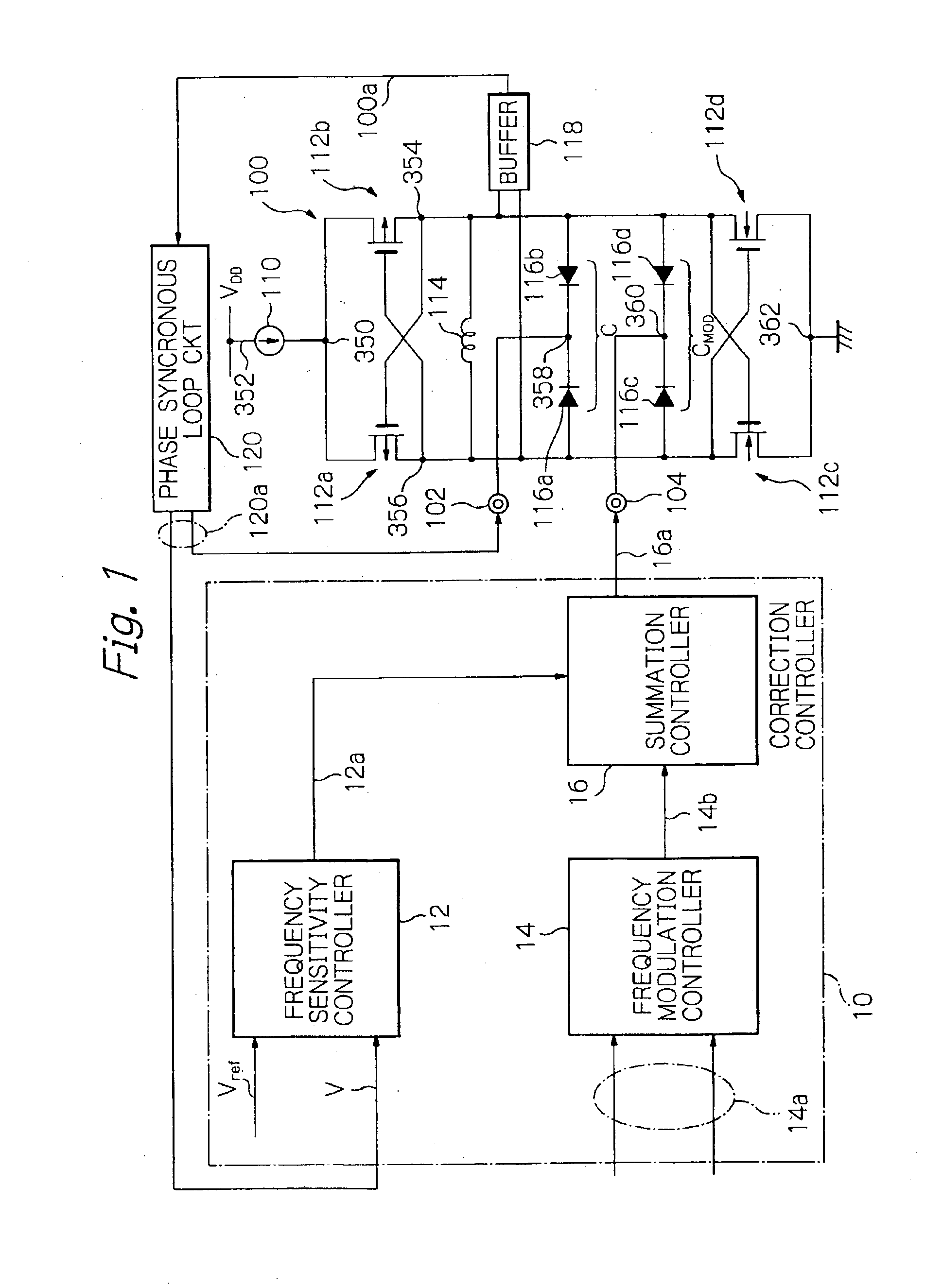Frequency modulation corrector keeping a good oscillating signal quality and suppressing dependability of a modulation degree
a frequency modulation and corrector technology, applied in the direction of angle modulation details, oscillating generators, pulse automatic control, etc., can solve the problems of increasing the modulation degree to frequency, complicated structure of the resonant circuit, and bulky resonant circuit, so as to reduce the capacitance of the second capacitor element, suppress the carrier frequency dependency of the modulation degree, and reduce the modulation degree
- Summary
- Abstract
- Description
- Claims
- Application Information
AI Technical Summary
Benefits of technology
Problems solved by technology
Method used
Image
Examples
first modification
(First Modification)
With reference to FIG. 5, the frequency sensitivity controller 12 includes an operational amplifier 12c, resistors 12d and 12e, a transfer gate 12f and a frequency synthesizer 12g, interconnected as shown. The parts or components common to those of the previous embodiment are denoted with the same reference numerals and hence the description on the corresponding operation is omitted for simplicity. The resistor 12e, grounded, includes resistors 120e and 122e, which are connected in series with each other to establish the same resistance value as the resistor 12e of the embodiment shown in FIG. 3.
The transfer gate 12f is a switching element responsive to the control signal 12h supplied thereto for switching itself between the conductive and non-conductive states. The transfer gate 12f is connected in parallel with the resistor 120e. The transfer gate 12f operates responsive to the control signal 12h supplied from the frequency synthesizer 12g to be conductive in r...
second modification
(Second Modification)
Referring to FIG. 7, the frequency sensitivity controller 12 includes an operational amplifier 12c, resistors 12d and 12e, transfer gates 12f, 12i and 12j, and a frequency synthesizer 12g. It is noted that the same reference numerals as those used in the previous embodiment or modification are used to designate the corresponding parts or components and the detailed description therefor is omitted for simplicity.
In the present embodiment, shown in FIG. 7, the resistor 12e is comprised of a parallel connection of a series connection of a resistor 200 and the transfer gate 12i and another series connection of a resistor 202 and the transfer gate 12j. The transfer gate 12f is connected in parallel across the resistors 12d and 122e, as in the previous embodiment.
The frequency synthesizer 12g is of the same configuration as in the first modification, and has the function of generating and outputting control signals 12h and 12k, adapted for opening and closing the tran...
third modification
(Third Modification)
The third modification will now be described. In the present embodiment, the frequency sensitivity controller 12, shown in FIG. 3, is applied so as to change the amplification factor of the frequency modulation controller 14 as shown in FIG. 9.
The frequency modulation controller 14 is basically similar to the configuration shown in FIG. 3 except that resistors 148a and 148b, transfer gates 148e and 148f, and a frequency synthesizer 148g have been added in the frequency modulation controller 14 shown in FIG. 9.
The resistor 148a includes a series connection of resistors 1480 and 1482, while the resistor 148b includes a series connection of resistors 1484 and 1486. The transfer gates 148e and 148f are connected in parallel with the resistors 1482 and 1484, respectively. The nodes 364 of the parallel connection of the transfer gates 148e and 148f are connected in common.
The frequency synthesizer 148g includes a programmable counter 1488 which forms a component of a f...
PUM
 Login to View More
Login to View More Abstract
Description
Claims
Application Information
 Login to View More
Login to View More - R&D
- Intellectual Property
- Life Sciences
- Materials
- Tech Scout
- Unparalleled Data Quality
- Higher Quality Content
- 60% Fewer Hallucinations
Browse by: Latest US Patents, China's latest patents, Technical Efficacy Thesaurus, Application Domain, Technology Topic, Popular Technical Reports.
© 2025 PatSnap. All rights reserved.Legal|Privacy policy|Modern Slavery Act Transparency Statement|Sitemap|About US| Contact US: help@patsnap.com



